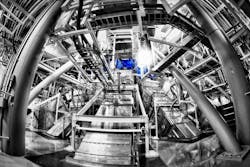Sydor Technologies signs $200K Phase 1 SBIR contract with US Department of Energy (DOE) for new ultra-fast, radiation hardened x-ray imager development
ROCHESTER, N.Y., [Sep 13, 2022] ‒ Sydor Technologies, a global leader in advanced x-ray detectors, was awarded a Phase I Small Business Innovation Research (SBIR) grant for the development of a ultra-fast, radiation hardened hybrid-CMOS x-ray detector for high energy x-ray research. Funding is valued at $200,000 and is being provided by the US Department of Energy (DOE).
The detection of optical light has made steady advances over decades to the point where observing sub nanosecond events has become routine, but detectors in the x-ray regime have not kept pace. As a consequence, radiation hard, x-ray imaging detectors with frame rates > 10 Hz are lacking. This technology gap is not only detrimental to scientific progress in traditional x-ray science fields like free electron lasers (FELs), but also in studying high energy density (HED) events like fusion. National laboratories had no choice but to start developing solutions to serve their own research facilities. To begin filling in these technological gaps, Sandia National Lab has been refining a pixel array detector under their UXI program for many years. This detector is a radiation hard burst rate imager, capable of capturing up to 8 frames with nanosecond gate times, which is an important step to begin filling in the technological gaps. The program developed a series of radiation hard CMOS sensor-based detector systems for use at SNL and several national laboratories, and is often referred to as ‘hCMOS’ by the partnering FES facilities (herein UXI system). The sensor group developed a ROIC (read out integrated circuit) that captures 2-D data with a minimum gate time of 1-2 ns and only tens of picoseconds of jitter. The “Icarus”, is the most prevalent ROIC and the most widely used in UXI detector systems at partnering facilities (i.e. Lawrence Livermore National Laboratory, LLNL) for fusion event imaging and diagnostics.
The main objective of the Phase I SBIR program awarded to Sydor Technologies will be to study the design of the national lab developed ROIC and generate a product roadmap for a new, more robust commercial camera system of use to all labs needing this innovation. The result will be an ultra-fast, radiation hard, x-ray imager for advanced laser diagnostics. Designing a commercial device based on the imaging ROIC will result in camera configurations that serves a broad range of scientists in the FEL, fusion, and HED physics communities.
Dr. Ben Martin is Sydor’s Technology Development Manager and Principal Investigator on this hCMOS project. Dr. Martin said, “I am looking forward to adding the new hCMOS technology to Sydor’s portfolio of x-ray detectors. This will help broaden our company’s reach in the HED community, bringing much needed commercial support for a popular detector architecture that many of our professional partners and customers need.“
This project will advance a program to grow ultra-fast imaging detector technology for HED physics and synchrotron markets. The research will result in a new GHz burst imaging detector with < 2 ns resolution that can be applied to a variety of scientific applications. As the US moves toward cleaner sources of energy, fusion holds the key to a clean energy future. The next generation of hard x-ray detector technology resulting from this work will enable practical applications of fusion technology through fundamental understanding of the physics behind it.
About Sydor Technologies
Sydor Technologies is a global leader in providing complex measurement solutions that generate critical results for the world’s most advanced applications in the defense, energy, ballistics, security, space, and research industries. Established in 2004, Sydor Technologies is headquartered in Rochester, NY and now supplies systems and support in over 33 countries. For additional information, please visit www.SydorTechnologies.com
